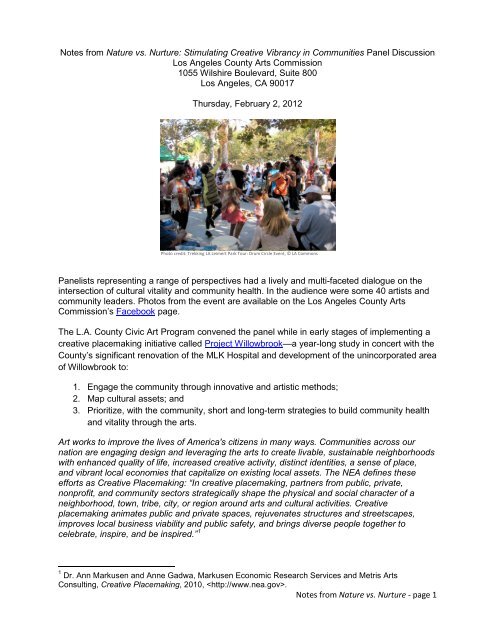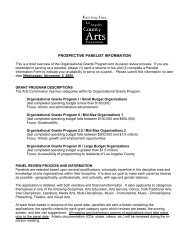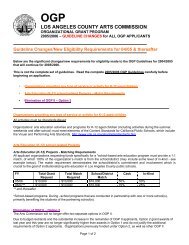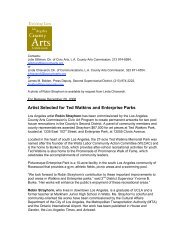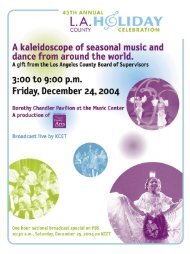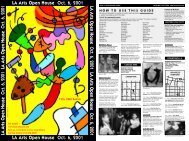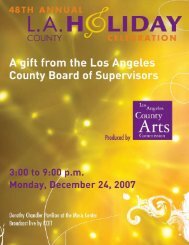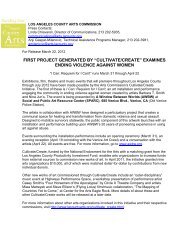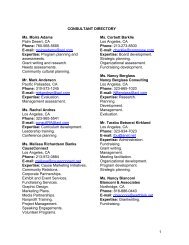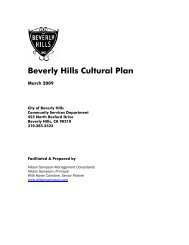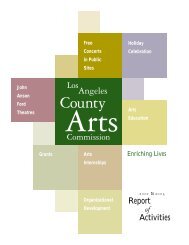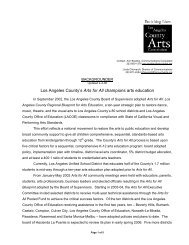Notes from Nature vs. Nurture - Los Angeles County Arts Commission
Notes from Nature vs. Nurture - Los Angeles County Arts Commission
Notes from Nature vs. Nurture - Los Angeles County Arts Commission
- TAGS
- nurture
- arts
- www.yumpu.com
Create successful ePaper yourself
Turn your PDF publications into a flip-book with our unique Google optimized e-Paper software.
Olga: It is critical for government agencies to codify best practices and what they are looking forin terms of design. We have a Mayor’s Advisory Panel that helps our agency vet projects thatare going to be built in the City of <strong>Los</strong> <strong>Angeles</strong>. It brings a degree of professional involvementthat was not previously there. In the past 25 years, vast accomplishments have been made.Q: It seems like most of the conversation has been site-specific. I work a lot with immigrantcommunities, and a lot of what we talk about deals with deep community networks, things thatcannot be measured physically. Are there new models for community communication andcommunity support?Maria: Through a planning and community and economic development prism, it’s always achallenge—when you look at any community with a unique identity, you’re right that space andidentity don’t always jibe. I don’t think that the planning field has tackled that in practical ways.How that theory translates into programs and policies that can support artwork or other kinds ofservice interventions…I don’t think we have a handle on that yet.Olga: Yes, it’s been part of the conversation, but not deeply. The Ford Foundation has workedwith making grants in immigrant communities, in terms of artists who are keeping traditions aliveor who are bringing traditions forward into contemporary times, or who are engagingcommunities through the arts. I think that there is even an affinity group that deals with fundersof immigrant art. There’s research that’s been done about how much the US funds internationalart practices. But it’s not prioritized.Jason: My last question for everyone. How do we do this well, how do we do creativeplacemaking right?Elizabeth: Find out where the creative pulse is. Don’t force something you wish was there. Talkwith people. I say this as a researcher locked in the ivory tower. The most enlightenedconversations I’ve had were not with my datasets but with people in galleries, who are living andbreathing what happens. Ask: what is it that you need, on a day to day basis, to do your job?Edgar: We [artists] are constantly putting ourselves into situations in which we must create.Watts House Project—what makes it lasting and ultimately meaningful is if you’re able to fosterreal trust and rapport with the people you are interacting with which allows you to do things farquicker than you would be able to otherwise.Olga: I think it’s about listening, and having a hypothesis based on things that have worked, andhow that may or may not work in the present context. Always work with people in the front lineof action. Each one of these actions is complex and you’re a fool if you don’t think it is. Youneed to be able to speak with a bureaucrat, an elected official, an artist, a community activist allof whom have different languages. We must master being fluent in those before doing anythingelse.Maria: A lot of this is unchartered territory, and you need the space and flexibility to take somerisks, and that everything is not going to be a straight line to a given impact. Everything in theend may not look like what you thought.Jason: The NEA wants to see experimentation. We’re not expecting everything to be perfect.The arts are about risk-taking.<strong>Notes</strong> <strong>from</strong> <strong>Nature</strong> <strong>vs</strong>. <strong>Nurture</strong> - page 7


